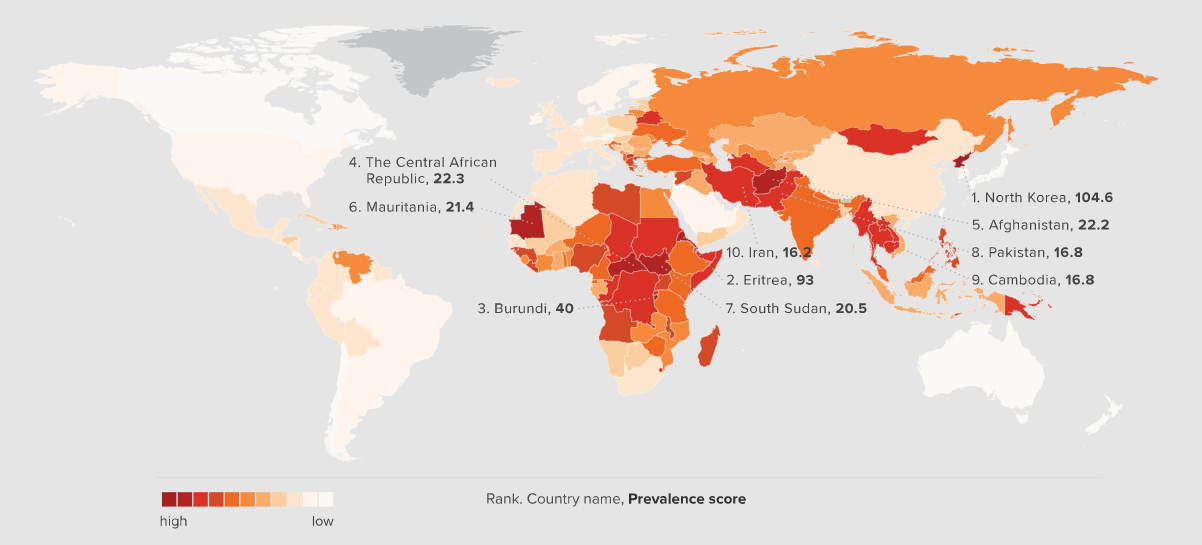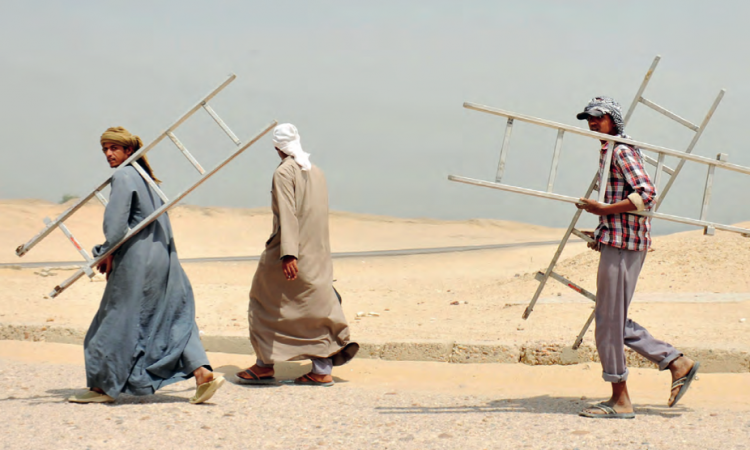An estimated 40.3 million men, women, and children were victims of modern slavery on any given day in 2016.1 Of these, 24.9 million people were in forced labour and 15.4 million people were living in a forced marriage. Women and girls are vastly over-represented, making up 71 percent of victims. Modern slavery is most prevalent in Africa, followed by the Asia and the Pacific region.

Although these are the most reliable estimates of modern slavery to date, we know they are conservative as significant gaps in data remain. The current Global Estimates do not cover all forms of modern slavery; for example, organ trafficking, child soldiers, or child marriage that could also constitute forced marriage are not able to be adequately measured at this time. Further, at a broad regional level there is high confidence in the estimates in all but one of the five regions. Estimates of modern slavery in the Arab States are affected by substantial gaps in the available data.2 Given this is a region that hosts 17.6 million migrant workers,3 representing more than one-tenth of all migrant workers in the world and one in three workers in the Arab States, and one in which forced marriage is reportedly widespread, the current estimate is undoubtedly a significant underestimate.
Countries with the highest prevalence of modern slavery:
- North Korea – 104.6 estimated victims per 1,000 population
- Eritrea – 93 estimated victims per 1,000 population
- Burundi – 40 estimated victims per 1,000 population
- the Central African Republic – 22.3 estimated victims per 1,000 population
- Afghanistan – 22.2 estimated victims per 1,000 population
- Mauritania – 21.4 estimated victims per 1,000 population
- South Sudan – 20.5 estimated victims per 1,000 population
- Pakistan – 16.8 estimated victims per 1,000 population
- Cambodia – 16.8 estimated victims per 1,000 population
- Iran – 16.2 estimated victims per 1,000 population
An analysis of the ten countries with highest prevalence indicates a connection between modern slavery and two major external drivers- highly repressive regimes and conflict. As the data in this Global Slavery Index confirm, several of the countries with the highest prevalence of modern slavery – the Central African Republic, Afghanistan, South Sudan, and Pakistan – also score above 90 percent in the Vulnerability Model, which measures systemic, individual, and environmental risk factors in 167 countries. The interplay between modern slavery and risk factors is discussed further below.
Despite a change in methodology, Mauritania and Cambodia remained in the top 10 in 2018. Mauritania continues to host a high proportion of people living in modern slavery. The national survey confirmed the existence of forced marriage and forced labour. Forced labour was found to occur in different sectors, to both males and females across different age groups and geographic regions. The practice is entrenched in Mauritanian society with slave status being inherited, and deeply rooted in social castes and the wider social system. Those owned by masters often have no freedom to own land, cannot claim dowries from their marriages nor inherit property or possessions from their families. Despite improvements to legislation in 2015, which strengthens the provisions on slavery, allows third parties to bring cases on behalf of slavery victims, and establishes special tribunals to investigate slavery crimes, progress in Mauritania remains slow.25 There are reports that police and the judiciary are reluctant to implement the new legislation and that several cases of slavery have been reclassified as lesser crimes, although the ILO Committee of Experts notes some positive steps in recent times.26 In Cambodia, men, women, and children are known to be exploited in various forms of modern slavery – including forced labour, debt bondage and forced marriage. While the prevalence of forced sexual exploitation and forced begging in the country has been reported previously, the national survey also pointed to forced labour in manufacturing, farming, construction and domestic work. In Cambodia, the government has been slow to improve their response to modern slavery.
Many of the countries with the highest estimated levels of prevalence are marked by conflict – Eritrea, Burundi, Central African Republic, Afghanistan, South Sudan, and Pakistan all appear among the 10 countries with highest prevalence. The role that conflict plays in compounding vulnerability to slavery is widely recognised and finds support in an assessment of vulnerability at the national level. In the Walk Free Foundation’s assessment of vulnerability across five dimensions – governance issues, lack of basic needs, inequality, disenfranchised groups, and effects of conflict – countries with high vulnerability due to effects of conflict generally have higher vulnerability scores across the remaining four dimensions. This is not surprising given the disruption to, and often complete dismantling of, the rule of law, as well as damage to critical infrastructure and limited access to education, health care, and food and water as a result of conflict. Similarly, the Walk Free Foundation’s government response data highlight the disruption caused by conflict to government functions. Eritrea, Central African Republic, Pakistan, and Iran all score lowly on government responses, while Afghanistan and South Sudan were excluded from the government response assessment this year due to significant ongoing conflict.
The improved measurement of state-imposed forced labour reveals the substantial impact this form of slavery has on populations. The three countries with highest prevalence – North Korea, Eritrea, and Burundi – stand out has having a very high prevalence of state–imposed forced labour. State-imposed forced labour includes citizens recruited by their state authorities to participate in agriculture or construction work for purposes of economic development, young military conscripts forced to perform work that is not of military nature, those forced to perform communal services that were not decided upon at the community level and do not benefit them, or prisoners forced to work against their will.28 In North Korea, one in 10 people are in modern slavery with the vast majority being forced to work by the state. See "Spotlight: Forced Labour in North Korea" on this page for further analysis.
Governments that regularly impose forced labour on their citizens perform poorly across other measures of vulnerability. For example, they tend to be more autocratic, are believed to have lower quality policy and regulations, perform below the global average in ensuring access to necessities such as food and water and health care, and typically do not protect the rights of highly discriminated groups in the broader population. More specifically, the presence of state–imposed forced labour undermines at best, and at worst renders meaningless, any government response to modern slavery. North Korea has the weakest response to modern slavery globally due to the state’s role in forced labour both within North Korea and of North Koreans abroad. The abuse of civic duties in Burundi and conscription in Eritrea also threatens any concrete actions these governments may be taking.
The prevalence of modern slavery in highly developed, high–income countries is higher than previously understood. This learning reflects improvements in the methodology, in particular, the ability to systematically count cases at the point of exploitation which was made possible with a substantially larger number of surveys. For example, if an Indian man reported being exploited in the construction sector in the United Arab Emirates (UAE), that case was attributed to UAE. In the five-year reference period for the estimates, while surveys were conducted in 48 countries, men, women, and children were reported to have been exploited in 79 countries. This results in higher estimates in countries such as the United States, Australia, United Kingdom, Germany, France, the Netherlands, and several other European nations.
While these findings emphasise the responsibility of highly developed countries to act, the estimates reveal only part of the picture. It is important to note that the governments in several of these countries – the Netherlands, the United Kingdom, the United States, Sweden, Belgium, Croatia, Spain, Norway, Portugal, and Montenegro – are also taking the most action to respond to modern slavery. These countries also tend to have lower vulnerability scores across all measures, which reflects effective governance across a broad range of areas and, in particular, a strong capacity to provide protections for vulnerable subgroups and ensure access to necessities such as food and water. Collectively, these factors mitigate risks of enslavement for citizens. However, higher prevalence of modern slavery among these countries suggests that critical gaps remain around the implementation of existing legislation and policies and in tackling the root causes of exploitation. It is very likely that this reflects the reality that, even in countries with seemingly strong systems, there are gaps in protections, with certain groups such as irregular migrants, the homeless, or minorities subject to intense and widespread discrimination and typically less able to access protection. In Europe, which has had a very strong response to modern slavery, there has been a tightening of migration policy and a reduction in the protections available to migrants in recent years. While in part this is a response to the current refugee and migrant crisis, this also renders these individuals more vulnerable to modern slavery. Similar approaches have also been adopted in the US and Australia.
On the other hand, when our assessment of government responses is correlated against GDP (PPP) per capita, we find that some highly developed, high-income countries have taken limited action to respond to modern slavery. Countries including Qatar, Singapore, Saudi Arabia, and the UAE have taken limited action despite high levels of resources. These countries tend to perform relatively well in comparison with other countries in the region on overall vulnerability scores given their greater capacity to address areas of critical need for citizens. However, there remain gaps in protections for migrant populations, often the most vulnerable groups to modern slavery in these countries. Even a seemingly strong response is undermined where there are subgroups of people who suffer high levels of discrimination, as they are likely to be “left behind” where responses to slavery are concerned. This can be linked to a lack of legal status in a country, for example, women in Saudi Arabia, domestic workers who fall outside the protection of labour laws in most Gulf countries, or the stateless hill tribes of Thailand and the Rohingya people of Myanmar, the latter of whom are at the center of the world’s fastest growing refugee crisis.
The 10 countries with the largest estimated absolute numbers of people in modern slavery include some of the world’s most populous. Collectively, these 10 countries – India, China, Pakistan, North Korea, Nigeria, Iran, Indonesia, Democratic Republic of the Congo, Russia, and the Philippines – account for 60 percent of people living in modern slavery and over half the world’s population.
IMAGE CREDIT: ILO

